Question of the Month
February 2011
Mountain Lion Reports
Any Truth
?
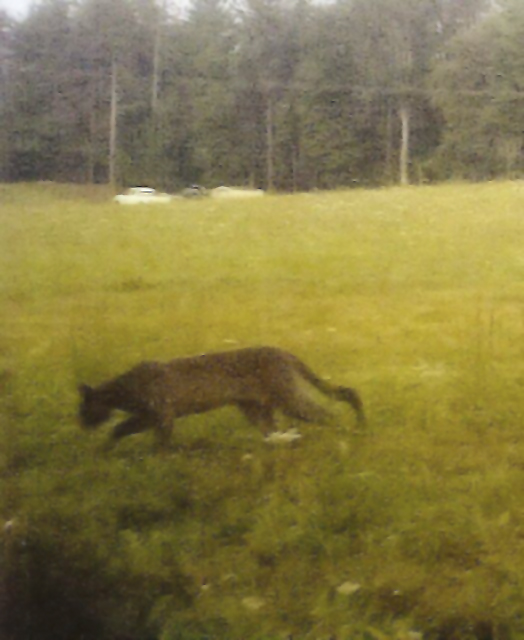
Please keep scrolling - ALL the Puma posts are included
About six months ago I posted the question, Are there Mountain Lions in Pennsylvania? Over the last few months several people have responded to this question with reports of their own. One man sent me a game camera photo that was blurry but looked like a mountain lion, or puma, as I like to call them. Mary saw the photo, too, and she immediately agreed, it was a puma. The photographer had no reason to stage the shot -- indeed, the composition and background was terrible, and not what you'd expect for something staged, but the shot wasn't perfectly clear.
Two different people told me that they, or a close relative, had seen pumas on more than one occasion. One man, in the southwestern part of Pennsylvania, had seen one, at night, about 25 years ago. He said he'd never forget the sighting, but it was only when he saw another, a few months ago, in daylight, from his cabin, that he decided it was time to tell someone.
Two other reports went, in detail, on what they saw, the size, the length of tail, etc. And again, while they may have been mistaken, they certainly were completely convinced that they had seen a puma. I believe them.
.jpg)
.jpg)
.jpg)
.jpg)
The image in the Upper Left was from a Game Camera, sent to me by a friend. The other three images are from my file, selected to most closely approximate the pose of the cat from the game camera. I have three observations here: 1. I am bothered by the constricted neck of the cat on the game camera; 2. the tail is curved down, rather than up, but it may have been in mid-swing; 3. the goldenrod-appearing flower, and the background of cars, gives a sense of scale and location. Had this been faked, I'd suspect the hoaxter would try for a more authentic background.
Because the neck bothered me, I decided to do some Photoshop on the puma in the lower left, moving his head higher up and changing the image to a contrasty black and white - to give a silhouette for comparision. Here it is:
.jpg)
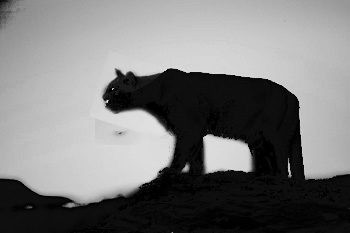
I still couldn't get the big head/little neck, and the body is a bit stouter/shorter, but a striding cat might be stretched out a bit. You be the judge.
I'll offer my own little anecdote. Recently, on a back road in Pennsylvania, a friend and I had our first sighting of a coyote in Pennsylvania. My friend was a former hunter and fisherman, and spent a lot of time in the woods, as did I, but neither of us had ever seen a coyote. This one streaked across the road in the early evening, and fortunately, it stopped when it climbed a hill on the other side where I had another view from my side of the truck. But even without that second look there was no question that we'd seen a coyote. A brief look, yes, but no question we saw a coyote.
Now, forty years ago coyotes were rare or almost nonexistent in Pennsylvania, and had had that same sighting back then, when coyotes were thought not to exist within the state we would have had the 'facts' to doubt what we saw. However, my friend and I discussed this, and agreed, we saw what we saw, and had it been 40 years ago or four months ago, we knew we saw a coyote.
I believe that the folks that are reporting, in detail, their sightings are faced with a similar situation. They know what they saw, regardless of what the facts say, and they know they saw a puma. I've read a lot about this, and the usual explanation is the very human desire to see something, to see what someone wants to see, and thus these people are seeing bobcats or brown cats or dogs or foxes and, because they 'want' to see a puma, they do. But no one that I've communicated with had these preconceptions, and seeing what they saw was a complete surprise. And a bit of an unpleasant one at that, as they now faced ridicule or doubt whenever they discussed their sightings.
Their are two web sites I know of that dealt with eastern pumas, with the one, the Eastern Puma Research Network, concentrating on sightings in the east. Unfortunately, their web site no longer seems active, and has been taken over by some wacky drug product. Goggling Eastern Puma brings up other web sites, however, with varying levels of professionalism or credibility. The other site, The Cougar Network, is still active, and is reporting the cats expanding range from the West, but offers little about the phenomenon of Pennsylvania cats.
I am hoping that more and more people will learn of my own interest in this, and will pass on this information and that I'll receive more reports and, hopefully, sometime, a game camera photo that is definitive. On that, I've had emails sent with game trail photo attachments, or killed pumas, supposedly shot in Pennsylvania, but these were hoaxes. One of these days, though, I'll get one that won't be, and I hope that will be soon.
If you're interested in this, please pass on this link, and if you see a cat, please let me know!
Contact info@hoothollow.com
Mountain Lions in Pennsylvania?
Can so many people be wrong?
Please keep scrolling - ALL the Puma posts are included
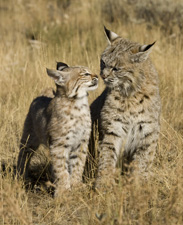

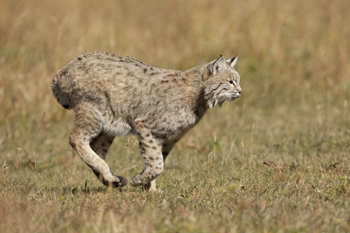
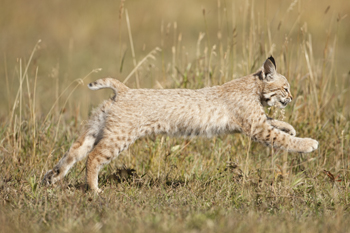
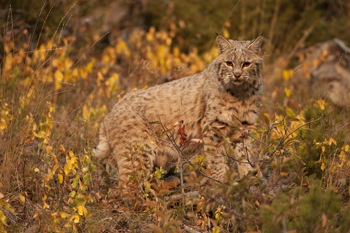
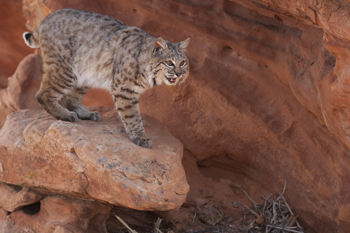
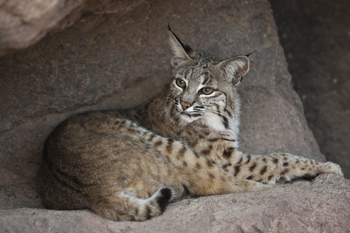
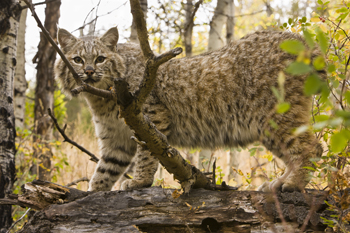
All of the above images are of bobcats. Note the size of the tail, the pointed ears, the speckled coat, the basic lack of white underneath.
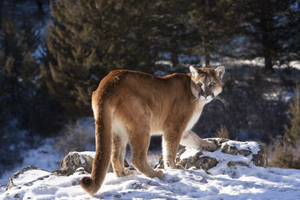
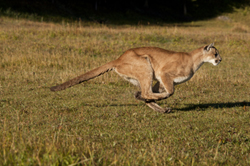
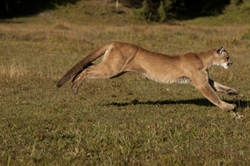
 running-066186 RAW.jpg)
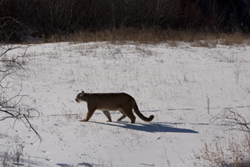
 0009.jpg)
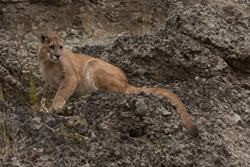

All of the above are Mountain Lions, or Pumas, or Cougars. Note the long, usually thick tail. The rounded ears,
the more visible white on the chest, the lack of spots, the huge hind quarters.
Although size can be difficult to determine in the field, a puma will be three or four times larger than a bobcat. The head of the puma is small in comparision to a house cat when compared to the entire body.
Can so many people be so wrong?
Periodically, via Google searches, I receive reports from people who believe they had seen a mountain lion in Pennsylvania, or in other mid-Atlantic states. I usually follow-up on these reports and, via email or phone conversations, I receive more details. Only once has anyone later determined that they had misidentified the cat, seeing a bobcat and not a mountain lion.
See also:
What does a Mountain Lion look like on a game camera?
Is there a Mountain Lion Conspiracy?
More Questions about Pumas in Pennsylvania
Are there Mountain Lions (Pumas, Cougars) in Pennsylvania and the Mid-Atlantic States?
Many of the reports I receive are extremely credible. In July and August I received seven different reports, and everyone involved had done a search of some type to compare images of bobcats and pumas. As you can see from the above images it is very difficult to confuse the two if you have a good view.
To be fair, I've also spoken with people who, at first, thought they'd seen a puma only to find, to their embarassment, that they were looking at a house cat! I've done this myself once, in Tanzania, when I saw a black house cat that I thought was a black leopard! The cat was far enough away that I couldn't get a size reference, and I believed the cat was further away than it actually was.
However, many of my reports were at distances that people knew, and as you look at the images of the puma there really is a big difference in color and shape between a puma and a house cat.
In only one report had an official from the Pennsylvania Game Commision, a local warden, actually agree with the person reporting the sighting. Everyone else, when reporting, were frustrated as they were told they had seen a bobcat. Check out the tails of the two! This will be one of your best identification marks, along with size.
I've spoken to PGC personnel, two being friends, and neither believe there are pumas in Pa. One cited how a bobcat's tail can be much longer than you expect, although I've never seen a bobcat tail longer than, at most, twice the size of the tails illustrated above of the bobcat. I don't believe someone's imagination could stretch a six inch long tail to three feet!
Interestingly, the US Fish and Wildllife Service has declared the Eastern Puma extinct, except for the Florida population known as the Florida panther. At one point, there was debate whether that cat should be protected, since its genes were diluted from escapees or released pumas that originated in South America or our West. It was decided that this shouldn't influence the decision and, in fact, an infusion of new genes produces a hybrid vigor, lessening the chance of in-breeding.
One might argue that the eastern puma is extinct, but that does not mean that there are not pumas (mountain lions, cougars) in the east. Where they always here as a relic population? Did they migrate south from Canada? Are they all the product of the off-spring of pumas that escaped their owners or were released? Who knows?
Interesting, too, are the reports I've heard from people who were told that they would be in big trouble if they shot a puma. This, after they were told that there were no pumas in Pa. I've looked in the PGC game laws booklet and saw nothing on this, which I guess you could conclude means a puma would not be legal to shoot. If it were, it would be listed. However, if it doesn't exist, and if someone saw one, wouldn't there be a worry that it was a dangerous escapee?
I hope no one ever shoots a puma to prove their existence here, but I hope someone gets a great photo, of the cat, of a road-kill, of tracks, and that I see it. I've seen hoaxes, of pumas carrying deer shot with game cameras, but these were of western cats. Hopefully, we'll see the real thing.
If you see a puma (mountain lion-cougar), contact me. Compare any game camera image with the shots above, or this game camera image, to confirm your identification. Good luck, and let me know!
Is there a Puma conspiracy?
A Mountain Lion Cover Up
?
Please keep scrolling - ALL the Puma posts are included
I don't want to seem like a nut case here, but I must ask this question and you'll soon understand why? Over the last two years I have occasionally posted a Question of the Month soliciting sightings from people who believed that they have seen a mountain lion in Pennsylvania or in other areas in the mid-Atlantic states.
I regularly ask hunters and outdoors people if they've ever seen a mountain lion, or know of anyone that has. Unless I am only dealing with a lot of delusional people with little judgment, something is out there. I receive about one email or phone call a month, on average, from people that I do not know who are contacting me because their sighting compelled them to do a Google search on puma sightings, and they found my site and previously posted questions. In personal contacts, that monthly average might even be higher. Let me explain this.
Very, very rarely, when I ask someone who would be a likely candidate (a hunter, someone who owns a camp in the deep woods, travels likely routes often, foresters), 'Have you ever seen a mountain lion?' do I get an immediate, 'Oh yeah!' Instead, the person usually pauses, sometimes with a sheepish or embarrassed expression on his face, and seems reluctant to continue. Most, quite honestly, don't know or can't believe or accept what they saw, they really can't believe their eyes. Recently, a man I spoke with told me that he was reminded of a sighting he and two friends had 20 years earlier, and after recalling the incident he was motivated to call his college buddies and reflect on their observation. When he told me this, he commented on how an experience like the one he and his friends had just is not forgotten. He saw a big cat. He knows and was familiar with bobcats, and it was not a weird house cat that he and his friends misjudged in size. But this one was black, and he knows mountain lions are some variant of brown.
In Michigan, there has been multiple sightings of 'black panthers,' animals that were thought to be mountain lions, or pumas, except that they were black. In Pennsylvania, I receive a few reports of black, big cats, which makes one wonder -- are there melanistic (black) pumas out there, or are those sightings always wrong. I've never seen or heard of a verified black puma anywhere, whether wild or captive, so I'd be inclined to dismiss reports of truly black big cats as misidentifications, even when a group of guys all see the same thing. However, recently I saw a photo of a melanistic bobcat, as black as could be, with bright yellow eyes. It had been captured in Florida, and was to be released.
An animal's coat can stray far from the norm. Everyone is familiar with albinism, the absence of pigmentation that results in a white, essentially pigment free animal, defined by pink skin and pink eyes. Albinos are often very light sensitive, and they certainly are conspicuous, and most do not live very long. Melanism is the reverse, where there is an abundance of dark or black pigmentation. Eyes are normal and are not light sensitive, and the over-all color, generally black, is usually not detrimental and may actually be of benefit. For example, leopards and jaguars, normally spotted cats, have a melanistic color morph, the 'black panther,' the black leopard or black jaguar. These color morphs are most common in rain forests and jungles. I've seen scores of leopards in the grasslands and deserts of East Africa and I've never seen, nor spoke with anyone, who has seen a black leopard there. In the forests of Kenya, however, they do occur.
In some areas, entire populations of a species exhibit this trait, for unlike albinism, which results in a conspicuous white color and light-sensitive pink eyes, there are no ill effects with melanism. Several populations of Gray Squirrels scattered around the country are black, and recently I heard of a neighborhood of black Eastern Chipmunks. So it happens, and who knows if it is existing in wild pumas in the East. It seems unlikely, considering captives have never shown this trait, but people are reporting big black cats. Who knows?
Recently the US Fish and Wildlife Service formally declared the Eastern Puma an extinct species, except for the remnant population in Florida. I have not spoken with a Game Commission officer personally, so I don't know whether anyone killing a puma in Pennsylvania could do so without legal repercussions. Hunters I've spoken with said they've been told you can't kill a puma, which they felt was ironic since the same official told them pumas don't exist in Pa. This is only hearsay, however, since I'm only going on their stories.
So how or why could there be a conspiracy?
Suppose, instead of declaring the puma, or Eastern mountain lion, extinct, the USFWS actually recognized the existence of the cat as a wild, breeding species. I'd suspect it would still be considered very rare, after all, it was thought to be extinct. Continuing with that thought, if that were so, then it'd be possible, if not very likely, that the Eastern puma would be an Endangered Species. So what?
Well, right behind our property lies a mountain ridge, one of several that makes a continuous forest that extends, with little interruption, for scores of miles in three directions. Flying over the area, I've looked down and commented upon the amount of habitat that would be available for a puma, if only they existed.
All of these forests are, with few exceptions, open to hunting, and hunting is a very important industry in Pennsylvania, New York, West Virginia, Maryland, and Virginia. Not only do hunting licenses support the various state game commissions, and in some states the acquisition and maintenance of public hunting lands, but hunters are a huge boon to local economies each fall, with purchases of food, lodging, hunting equipment, etc.
Now consider: If it was confirmed that there was a breeding population of endangered pumas on the mountain ridge behind my house, if the USFWS recognized the existence of this endangered species, what might happen?
Would my mountain ridge be declared 'Critical Habitat' for the puma? Would that declaration close that ridge to hunting? After all, skeptics often suggest that puma sightings are just deer sightings, so it would be logical to worry that a hunter might shoot an endangered puma, mistaking it for a brown deer.
Knowing that pumas range widely, would my ridge be the only one closed? Obviously, other pumas must be about, and the series of ridges extending north and east and west from my location could all be included as critical habitat as well. Would these ridges be declared off-limits for hunting?
If so, what would happen to the hunting industry in all of these states? I think it is possible that recognizing the existence of pumas in the East could jeopardize this industry and an entire economy. Again, I've been told that some Game Commission personnel have admitted that pumas may exist in Pennsylvania, but they rationalize this by saying that the pumas are not breeding and they are not from original wild stock. I don't know if a Game Commission authority has actually said this or not, but people I've spoken to have reported this.
If pumas do exist in the mid-Atlantic and Northeast, could they all be released cats or escapees? Possibly, but it seems unlikely that enough would have been released or had escaped to make for a viable population. After all, how many people have pumas? And how many would let them go, or provide an opportunity for escaping? Let's say the facts indicate that there have been a lot of 'pet' pumas, and many of these escaped. I've know of reports since 1973, in Cooke Forest, the heart of a lot of Pa. wilderness. Where reports dating that far back from escapees?
Now, if there were any escapes, and if any of these bred with a possible minuscule number of eastern pumas, a relic native population, wouldn't the gene pool be corrupted? Would a puma then qualify as a native species? Consider that the endangered Florida puma has mixed genes. At one time this fact almost resulted in this cat not being protected, since it wasn't a pure strain. Over time, cats that had been released in Florida, probably pets that outlived their welcome, bred with the native puma, and their genes mingled.
This is actually a good thing, as genetic isolation generally weakens a species. And this genetic mix has been recognized, and the Florida puma is still protected. So, couldn't that same argument apply to pumas in the Northeast?
I'm wondering, then, if the complete dismissal of sightings of Eastern pumas (other than the acknowledgement of released or escaped pets) isn't motivated by economics. I'm thinking of the solution often suggested for pesky endangered species out west, namely wolves and grizzly bears. That solution: Shoot, Shovel, and Shut Up. Are the various States guilty of essentially the same thing? If we don't see it, it doesn't exist. If we say it ain't so, it ain't so!
On that note, I was speaking with a Fed Ex driver recently who told me that one of his colleagues had seen what he swore was a dead mountain lion on the side of a road. A Game Commission vehicle was there, and the Fed Ex driver, after reaching the bottom of a long hill, turned back to check on what he saw. By the time he returned the vehicle was gone, and so was the cat, and no mention was ever made of this road kill in a radio or newspaper report. Perhaps my Fed Ex driver was simply recalling a rural legend, but he said it was an employee that he knew, and it was a story he heard first-hand.
Something to consider, even though we all trust the government. They are there to help us.
 6993.jpg)
Controlled situation. Not a wild puma!
Mountain Lion Reports
Are there pumas, or mountain lions, in Pennsylvania and the mid-Atlantic States?
Please keep scrolling - ALL the Puma posts are included
I love the big cats and devote a huge amount of my field time photographing African lions, leopards, cheetahs, and in 2011, tigers. I've seen about 20 mountain lions, or pumas, in the field, but all but 2 were in Chile. Those special two were across a river just outside Glacier National Park in Montana, and consisted of a mother and two cubs (Mary saw both cubs, I only saw one, and we did so separately, as we were driving two vehicles).
At one time mountain lions, or more properly puma (Puma concolor), enjoyed the widest geographic range of any New World mammal, and were found throughout all of the contiguous United States. By the mid-1900s pumas were eliminated from almost all of the eastern states, and by mid-century were officially extinct east of the Mississippi, except for a remnant population in southern Florida.
Certainly it is a romantic notion, but I've always held out the hope that pumas still roamed the east. With that hope in mind, I have, for years, asked outdoors people if they ever heard of a mountain lion, or puma, in their area -- with my questioning limited to people in my home state of Pennsylvania.
Each year, over tha past five, I've spoken with at least one person who swears they personally saw a puma in this state. One sighting I give complete belief in was from a friend who told me a puma crossed right in front of their vehicle, and paused on the berm for a few seconds, at a distant of ten yards or less.
Here in central Pennsylvania we live on the outskirts of what one puma-tracking website has as almost the high point of sightings, extending from north-central Pennsylvania in a southwestern diagonal that extends into the mountains of West Virginia. Most of the people I've spoken with live in this belt, but biologists friends I've spoken with have told me of their own reports, first-hand, from hunters in the Poconos who saw pumas, too.
I could fill pages recounting the eye-witness reports I've heard, and for every report critics could certainly say 'but there's no physical evidence!' That's true. In books I've read critical or skeptical or down-right dismissive of the idea of pumas in the East, the argument has been advanced that the hopefull puma-dreamer/spotters arguing that the State needs to prove pumas don't exist does not mean that in the State not proving this means that pumas indeed do exist in this state.
I can't dismiss the eye-witnesses I've interviewed. A few could, perhaps, be mistaken idenity. For example, one man I interviewed said he saw a 'black' puma, and this should disqualify his sighting as a black puma has never been recorded. He saw his cat at very close range -- 20 yards or less, and when I pointed out to him that pumas are never black he said that perhaps it was the light. A dark brown puma, backlighted by a strong sun, could appear all black, or very dark, and he accepted that. But more importantly, he also said that regardless of color, he saw a big cat, with a tail that looked to be about 4 feet long! He's a hunter, a woodsman, and he's seen a lot of game, so I can believe he saw a back-lighted puma.
The State argues that there is no physical evidence, and no credible photographs. The State cites that there are no road-kills, and in a heavily trafficed state like Pennsylvania there should be kills. However ...
I spend a lot of time outdoors, and I've seen about 10 black bears in Pennsylvania, and all within ten miles of my home. I'm a photographer, yet I've never had a chance to snap a photograph of one of these bears. The sightings were great bear views, but too fast or fleeting to allow me to grab a camera. I used to archery hunt for deer, and I spent a lot of time (way too much time) sitting silently in a tree stand waiting for deer. In all those hours I never saw a coyote, bear, or bobcat, and yet all live in my area.
I asked our Game officials about evidence, and they cite no road kills. There are at least 20,000 black bears in Pa., and a small percentage are killed each year, but we're probably not talking about 20,000 pumas in the state. In Yellowstone, definite puma country (perhaps not ideal habitat, but pumas are found in every section of Yellowstone), I've spoken to guys on road crews and with rangers, each with 20 years of field or road experience in Yellowstone, and the ranger had only seen 2 (both road kills and together) and the road crew guys two or three in all their years.
On the other hand, there are probably thousands of game cameras covering water holes and game trails throughout Pennsylvania, and to my knowledge no one has yet recorded a puma. Conversely, an outdoor writer I know told me that when Pa. enacted a menagerie permit law years ago, 'a lot of mountain lions suddenly died,' as the owners of these cats, rather than going through the paperwork, simply released their pumas and claimed that they had died. Of course, the writer's comments were hearsay, but it does make sense.
State Game Officials do concede that some people may indeed have seen a puma, but it was undoubtedly a released captive. That may be true, or was once true, but even a declawed puma, if it can survive off rabbits and squirrels, and breeds, its offspring would be fully equipted to survive.
Interestingly, almost all of the people I've spoken to who claim to have seen a puma have not seen a bobcat, an animal that is common enough in Pennsylvania to support a legal trapping season! Have all of those who have seen a puma really seen a bobcat? What would account for the long tails? Imagination? Wishful thinking?
I'd love to hear of any reports you have. While the chances that I'll ever see a puma in Pennsylvania myself are virtually zero, I'm always on the alert -- for the bobcat I've never seen in Pa., for a fisher, bear, deer, red salamander, toad, or snake, and yes, I'm always hoping that I too will become one of those who saw something that officially cannot exist within the state, a puma I know I saw but, of course, could not have!
Let me know if you have seen one!
What does a Puma (Mountain Lion) look like on a Game Camera?
Please keep scrolling - ALL the Puma posts are included
Over the last few years I've done several Questions of the Month regarding Mountain Lions, or Pumas as they should properly be called, in the Mid-Atlantic States and in Pennsylvania. I have received about two dozen reports during that time, including one game camera image that still looks very credible to me.
Recently, on our Arizona Hummingbird and Bat Photo Shoot, I found a deer that had been hit by a car and had moved off to die beside a stream just 200 yards upstream from our lodge. When I first discovered this fresh carcass I examined it for throat punctures, thinking that it may have been killed by a puma. It wasn't, and I assumed it was a road-kill.
Nevertheless, I put up a MOULTRIE game camera -- a brand that I've had tremendous satisfaction with -- at the carcass, hoping that scavengers would visit. On the second night, a mountain lion passed by, apparently drawn by the smell but put off by the stench, as the cat did not visit the kill. I had three cameras positioned, so had a cat visited, I'd have had it.
Ironically, I almost deleted the image, as on the small camera LCD monitor the cat was small and I thought that it was just another deer that moved along the stream. Only when I reviewed the images on my laptop did I discover that I had a mountain lion! Imagine my surprise.
Granted, the image is not great, and I used some Photoshop adjustment layers to enhance the image, making it a bit easier to see. However, it is clearly a mountain lion, and I'm presenting this poor image as a baseline reference for anyone recording a mountain lion on a game camera, or seeing one. Remember, this one was photographed in Arizona in good puma country, although this was the first one I've recorded there. This is not a Pennsylvania puma!
If you see or photograph a puma in the mid-Atlantic states, please email or call me. I'll be anxious to learn of your report.
Questions of the Month
Are the Latest Fast CF Cards worth the Expense?
How does the 7D hold up in a recent shoot?
Which is the better camera, the Mark IV or the 7D?
Are there Mountain Lions (Pumas, Cougars) in Pennsylvania and the Mid-Atlantic States?
Why is bat photography so difficult?
What do I think of the Canon 1D Mark IV?
How do I deal with shaving weight for carrying my gear?
Why do I advocate manual exposure so avidly?
Where can I find Depth of Field reference charts?
What is the Kiboko backpack? Is it the New Best Pack?
Is there a correct position for the upright on a Wimberley actionhead?
How, Who, and Why? The story behind our new web site.
Archived Questions of the Month
Most of my original Questions of the Month for the last several
years are available through this link. The 'look' is from my
original web site, although if I ever have enough time I might
redo these pages to match the new web site But that's not
a high priority.


